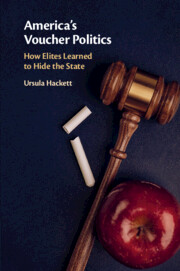Book contents
- America’s Voucher Politics
- America’s Voucher Politics
- Copyright page
- Contents
- Figures
- Tables
- Acknowledgments
- Abbreviations
- Introduction
- 1 America’s Foundational Identity Struggles
- 2 Two Dimensions of Attenuated Governance
- 3 The Racial Struggle
- 4 The Religious Struggle
- 5 The Public–Private Struggle
- 6 Tax Credit Scholarships in an Era of Republican Dominance
- 7 Education Savings Accounts and Controversies Beyond
- Conclusion
- Appendix
- References
- Index
1 - America’s Foundational Identity Struggles
Published online by Cambridge University Press: 20 April 2020
- America’s Voucher Politics
- America’s Voucher Politics
- Copyright page
- Contents
- Figures
- Tables
- Acknowledgments
- Abbreviations
- Introduction
- 1 America’s Foundational Identity Struggles
- 2 Two Dimensions of Attenuated Governance
- 3 The Racial Struggle
- 4 The Religious Struggle
- 5 The Public–Private Struggle
- 6 Tax Credit Scholarships in an Era of Republican Dominance
- 7 Education Savings Accounts and Controversies Beyond
- Conclusion
- Appendix
- References
- Index
Summary
Chapter 1 explains why policymakers have an incentive to engage in attenuation by situating the politics of the hidden state within America’s three foundational identity struggles: age-old, divisive, and recurrent contestation over race, religion, and civic institutions. The racial struggle pits a white supremacist order against a racial egalitarian order. Secularists and accommodationist orders comprise the religious struggle. The public–private struggle is the clash between communitarian and individualist orders. Elites use attenuated governance to pursue their policy goals amid intensive contestation when more visible programs would be struck down as unconstitutional. Sometimes these programs are also electorally unpopular, but policymakers’ chief fear is a legal one – that opposition groups will mobilize, and hostile judges will strike their programs down.
- Type
- Chapter
- Information
- America's Voucher PoliticsHow Elites Learned to Hide the State, pp. 9 - 32Publisher: Cambridge University PressPrint publication year: 2020

